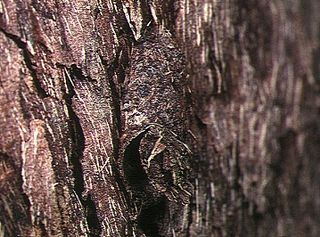
Nemesiidae, also known as funnel-web trapdoor spiders, is a family of mygalomorph spiders first described by Eugène Simon in 1889, and raised to family status in 1985. Before becoming its own family, it was considered part of "Dipluridae".

Barychelidae, also known as brushed trapdoor spiders, is a spider family with about 300 species in 42 genera. Most spiders in this family build trapdoor burrows. For example, the 20 millimetres (0.79 in) long Sipalolasma builds its burrow in rotted wood, with a hinged trapdoor at each end. The 10 millimetres (0.39 in) long Idioctis builds its burrow approximately 5 centimetres (2.0 in) deep, just below the high tide level, sealing the opening with a thin trapdoor.

Sason is a genus of bark-dwelling brushed trapdoor spiders first described by Eugène Simon in 1887. It is distributed from the Seychelles through India to northern Australia. The closest related genus seems to be the monotypic Paracenobiopelma.

Sason robustum is a species of barychelid trapdoor spiders. It is only found in southern India, Sri Lanka and the Seychelles.

Idiops is a genus of armored trapdoor spiders that was first described by Josef Anton Maximilian Perty in 1833. It is the type genus of the spurred trapdoor spiders, Idiopidae. Idiops is also the most species-rich genus of the family, and is found at widely separated locations in the Neotropics, Afrotropics, Indomalaya and the Middle East. Females live in tubular burrows lined with a thick layer of white silk. These typically have a D-shaped lid that fits into the entrance like a cork, and some burrows have two entrances. The lid may consist of mud, moss or lichen, which is bound below by a thick layer of silk. As in all genera of this family, the anterior lateral eyes (ALE) are situated near the clypeal margin, far in front of the remaining six eyes, which are arranged in a tight group. The males which are smaller in size, wander about or occasionally live in burrows. Like other mygalomorphs, they are relatively large and long-lived. Forest clearance and agricultural practices that loosen the soil and enhance erosion, besides soil removal for brick making have been pointed out as serious threats to some Indian species. Species ranges are poorly known – in India for instance, most species are known only from their type localities.
Poecilotheria hanumavilasumica, also known as the Rameshwaram ornamental, or Rameshwaram parachute spider, is a critically endangered species of tarantula.
Poecilotheria miranda, also known as the Bengal ornamental is a species of tarantula. The species is endemic to India.

Neoheterophrictus is a genus of tarantula in the family Theraphosidae. It comprises seven species, all found in India.

Poecilotheria vittata, sometimes called Pederson's ornamental, the ghost ornamental, or magam tiger spider, is an arboreal tarantula. It is endemic to Sri Lanka. In IUCN Red List, the species is cited as a synonym of Indian species Poecilotheria striata, but in other local text books and online publications, it is cited as a separate species. As of February 2016, the species was considered to be native to both India and Sri Lanka by the World Spider Catalog.
Sason rameshwaram is a species of spider in the family Barychelidae, found in India.
Diplothele halyi is a species of spider of the genus Diplothele. It is endemic to Sri Lanka. Differences from the type species Diplothele walshi include a large fovea and a less distinct abdominal pattern. The male is more hairy than female, with a slightly elevated spine. It was first described from the Nuwara Eliya area.
Sipalolasma ellioti is a species of spider of the genus Sipalolasma. It is endemic to Sri Lanka. The female is 11 mm in length.
Sipalolasma is a genus of brushed trapdoor spiders first described by Eugène Simon in 1892. It is restricted to South Asia and parts of Africa.
Sipalolasma greeni is a species of spider of the genus Sipalolasma. It is endemic to Sri Lanka. The carapace and legs are deep brown in color. The abdomen is black. The known length is about 22 mm. The species was first found from Punduloya, Sri Lanka.
Plesiophrictus is a genus of tarantulas that was first described by Reginald Innes Pocock in 1899.
Tigidia is a genus of brushed trapdoor spiders first described by Eugène Simon in 1892.

Conothele is a genus of mygalomorph spiders in the family Halonoproctidae, first described by Tamerlan Thorell in 1878. Originally placed with the Ctenizidae, it was moved to the Halonoproctidae in 2018.
Damarchilus is a genus of spiders in the family Nemesiidae. It was first described in 2015 by Siliwal, Molur & Raven. As of 2017, it contains 2 species, both from India.





